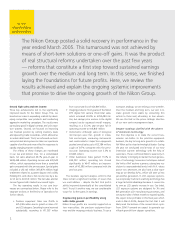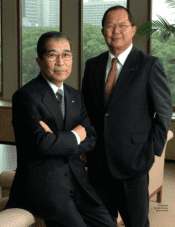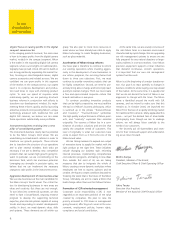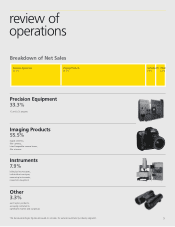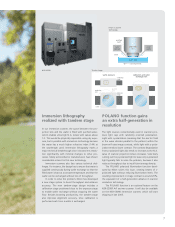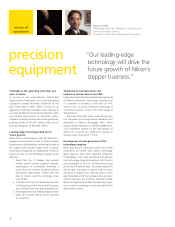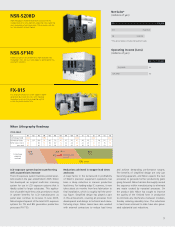Nikon 2005 Annual Report Download - page 14
Download and view the complete annual report
Please find page 14 of the 2005 Nikon annual report below. You can navigate through the pages in the report by either clicking on the pages listed below, or by using the keyword search tool below to find specific information within the annual report.
review of
operations
imaging
products
“Our creativity is a critical success
factor—for differentiating
product strategy and for
increasing profi ts.”
A leap forward in digital SLR cameras
The year ended March 2005 began with the
worldwide launch of the D70 digital SLR cam-
era to widespread acclaim. At the end of the
year, launches of new products included the
D2x, which has 12.4 effective megapixels to
satisfy the picture-quality needs of professional
photographers, and the D2Hs, which can man-
age high-speed shooting at eight frames per
second. Strong sales of digital SLR cameras and
interchangeable lenses helped segment sales rise
24.9% year-on-year to ¥355,489 million. Despite
steep price erosion in the digital compact camera
market, operating income amounted to ¥16,841
million, which was roughly in line with targets.
Further strengthening position in digital
SLR camera market
Since releasing the professional-use D1 in 1999,
Nikon has reinforced its position as a pioneer in
the digital SLR market. Launched in March 2004,
the D70 allows amateur enthusiasts to enjoy tak-
ing pictures with digital SLR cameras that boast
technology actually amassed for professional-use
cameras. The model was a hit, with cumulative unit
shipments reaching one million within a year. We
aim to stimulate the growth of this fast-expanding
market segment, which was formed initially from
high-end users, by broadening the user base to
include beginners as well as amateur enthusiasts.
Launched in June 2005, the D50 was the fi rst
model designed with this aim in mind, combining
simple operability with professional image quality.
This camera has received high praise from many
fi rst-time digital SLR customers and continues to
sell well. Going forward, we will expand sales by
augmenting our lineup to meet the needs of a
wide range of customers, from general users to
professionals, with the aim of reinforcing its posi-
tion as leader of the digital SLR market.
Revised product lineups for digital
compact cameras
Amid increasing popularity of digital compact
cameras and a shift in demand to digital SLR
cameras, the key to winning in the market lies in
launching attractive, high-value-added products
that can be differentiated from the competition.
In response, we have conducted a detailed
and multi-faceted review and analysis of target
users for digital compact cameras and are pro-
moting product planning in accord with this.
We have created a Customer Relationship
Management (CRM) system and have already
accumulated a variety of data on users in each
segment. Plans are in place to make full use of this
data in our marketing efforts, developing prod-
ucts that target different customers with varying
lifestyles and needs, rather than segmenting the
market according to price and pixels.
Cultivating a highly responsive and creative
corporate culture
The digital compact camera market has expand-
ed at astonishing speed. New entrants, including
several computer manufacturers and consumer
electronics fi rms, have joined the ranks of camera
manufacturers. Model life cycles have shrunk,
and price competition has become especially
fi erce. Further, as proliferation of digital cameras
progresses, customers are becoming more dis-
cerning about the kind of product they want. In
this fi ercely competitive market, we believe that
the critical success factors are as follows:
1. Development of new products with the Nikon
stamp of creativity to carve out new segments
by appealing to the imagination of consumers
2. Shift to more accelerated product develop-
ment programs
3. Comprehensive cost-reduction measures
to raise profi tability
Realizing these objectives involves major pro-
cess reforms to ensure maximal delegation of
authority and enable swift decision-making at all
stages of product development. We will quickly
create a system that enables new models to be
released to the market in the fastest time frame
possible by shortening all processes, from product
planning to development, design, production and
sales. Improving corporate structure and reinvent-
ing corporate culture are critical to expand future
business with cutting-edge digital technology. We
created a mechanism that transcends traditional
business divisions to spark greater cross-fertiliza-
tion of ideas from all people, beginning with
those in our product planning and development
departments. This is but one example of how we
are striving to cultivate a more creative corporate
culture in order to develop highly innovative cam-
era products tailored to the digital age.
Reinforcing our profi t structure through
comprehensive cost-reduction measures
The in-house manufacture of lens units, which
are key components of digital cameras, is a
strong driver of Nikon to boost margins for digital
compact models. We will expand the factory in
Wuxi, China, to enable greater production of lens
units (the year saw the completion of Nikon’s
third building in China). In an effort to further
strengthen our cost competitiveness, we will
create a highly effi cient integrated production
line from lens element press and processing to
lens unit production and camera assembly. At
our Thai facility, we will expand production of
digital SLR cameras and interchangeable lenses
and promote cost-cutting measures to raise
productivity in response to burgeoning demand.
Nikon is undertaking a comprehensive series of
measures to reduce costs from the development
and design stage. We are working to reduce
Makoto Kimura
Senior Managing Director, Member of the Board &
Senior Executive Offi cer
President of Imaging Company
12


